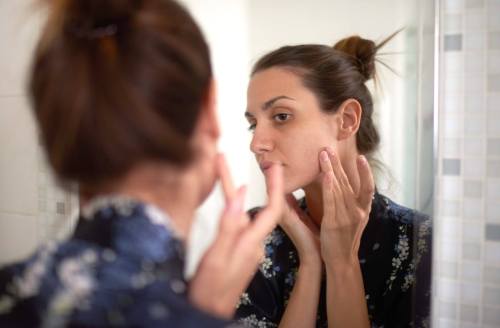The derm-approved action plan for when a pimple forms deep under the surface
Skin experts explain exactly what to do once you feel cystic acne forming beneath the skin.

Pimples are a pestilent, diverse breed. One thing that makes them particularly annoying is that you never know how they’ll make their grand entrance. Sometimes, you wake up with a fresh, juicy whitehead on your face, but then there are other times—just as undesirable times—in which you essentially get the message from beneath the surface that a pimple’s a-brewin’ weeks before anything shows up on your skin. That’s how you know you’ve got cystic acne.
When the cyst is in ghost mode (AKA you still can’t see it on the surface quite yet) it can be helpful to know what you’re up against. “It’ll usually appear as a round, red bump under the skin that is sore or tender to the touch,” says Marnie Nussbaum, MD, a New York-based dermatologist. “There will be no whitehead at the top.” It could also be warm to the touch, since it’s actually a bacterial infection of your skin, according to skin-care expert Jenefer Palmer, Osea’s founder and formulator.
“Bacteria’s getting trapped inside the follicle and causing swelling as well as inflammation,” explains Dr. Nussbaum. This is why it’s pretty painful.
Along with a slew of other factors including genetics, you can expect these to typically pop up around that time of the month. “An imbalance of hormones is often to blame,” explains Palmer. But it’s not the kind of thing you can slap your regular pimple treatments on, like benzoyl peroxide or hydrocolloid patches, and call it a day—cysts require a strategic plan. Despite the fact that you can’t see anything, you should still start treating it as soon as you feel it coming. “Start treating it ASAP,” says Palmer. “Even with treatment, cysts can take several weeks to go away. When you start tackling it before it reaches the surface, I’ve seen infections clear up in two weeks or less, versus a month or more.”
Of course, despite how tempting it is, the solution is not to attempt popping it. “Once you feel a cyst, do not try to squeeze it as it’ll only pop under the skin, which will cause more swelling and inflammation,” says Dr. Nussbaum. “It’ll also take longer to heal, and possibly cause an infection.”
Ready to attack? Keep scrolling for your cystic acne treatment plan, according to the pros.

Your cystic acne action plan
1. See a dermatologist
This Parisian Skincare Brand Is Launching in the United States for the First Time—Here’s What a Derm Wants You to Know

We’re Calling It: Cleansing Balms Are the Face Wash of the Future—Here Are 3 to Add to Your Cart

This Is the One Product That Scarlett Johansson Always Keeps in Her Purse and on Her Bedside Table

First of all, if you can, head right to your derm’s office for a cortisone shot. “The best thing to do is get a cortisone injection, which will shrink the cyst within 48 hours,” says Dr. Nussbaum. Though it’s not in everyone’s get-rid-of-acne-stat repertoire, it does work.
2. Hit the ice
Know that ice cubes are your friend. “Place an ice cube in a paper towel over the cyst for 10 minutes on, 10 minutes off, for an hour to vasoconstrict the blood vessels, which will decrease inflammation,” says Dr. Nussbaum. “Don’t leave it on for too long since you can burn your skin with the ice.” Then wash your skin with a salicylic acid cleanser followed by a tiny bit of moisturizer.” She recommends then, after a few minutes, to apply a tiny bit of topical benzoyl peroxide.
3. Exfoliate
Palmer notes that any exfoliating cleanser such as the Osea Ocean Cleanser ($16) is helpful as well. “Use a gentle exfoliating cleanser–one with lactic acid or other naturally plant-based chemical exfoliating agents,” she says. This will rid the pores of bacteria and the top layer of dead skin cells so it’s easier to reach that cyst.
4. Keep it clean
It’s key to look for antibacterial ingredients in topicals to keep things clean and to prevent the infection from spreading. “Apply products with naturally antibacterial properties such as tea tree, rosemary, and thyme,” Palmer suggests. We like The Body Shop Tea Tree Targeted Gel ($10).
5. Stay hydrated
Whatever you do: Do not attempt to dry your pimple out. “Keep your skin lightly moisturized, since drying it out will just lead to increased oil production and further infection,” says Palmer. One way to do this is with a hyaluronic acid serum, which binds moisture into the skin without depositing breakout inducers. Try Skinmedica HA5 Rejuvenating Hydrator ($178) which contains five different molecular weights of hyaluronic acid to nourish from different depths within your complexion.
6. Lay off dairy
Bonus points for avoiding dairy, particularly during a cystic breakout. “We’ve had customers eliminate dairy from their diet,” says Palmer. “Not only does it often reduce the severity of cystic acne, but it seems to help prevent its occurrence.” Plus there are studies backing up the tie between dairy and inflammation—and at the very least, you want that inflammation gone.
To take control of your acne, here’s how to read your face to determine the root cause of your breakouts. And these are facialist and dermatologist-approved acne products.
Sign Up for Our Daily Newsletter
Get all the latest in wellness, trends, food, fitness, beauty, and more delivered right to your inbox.
Got it, you've been added to our email list.







